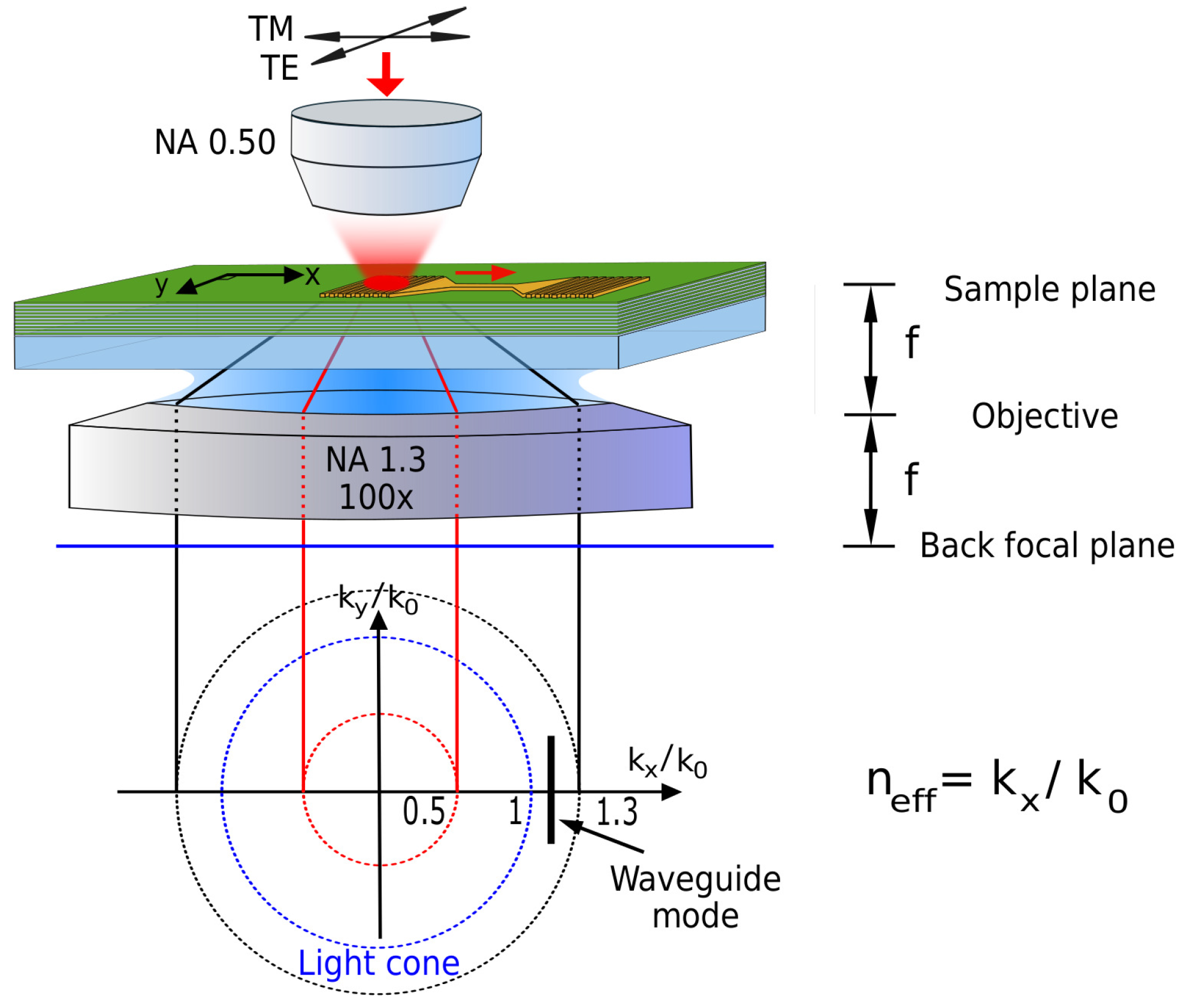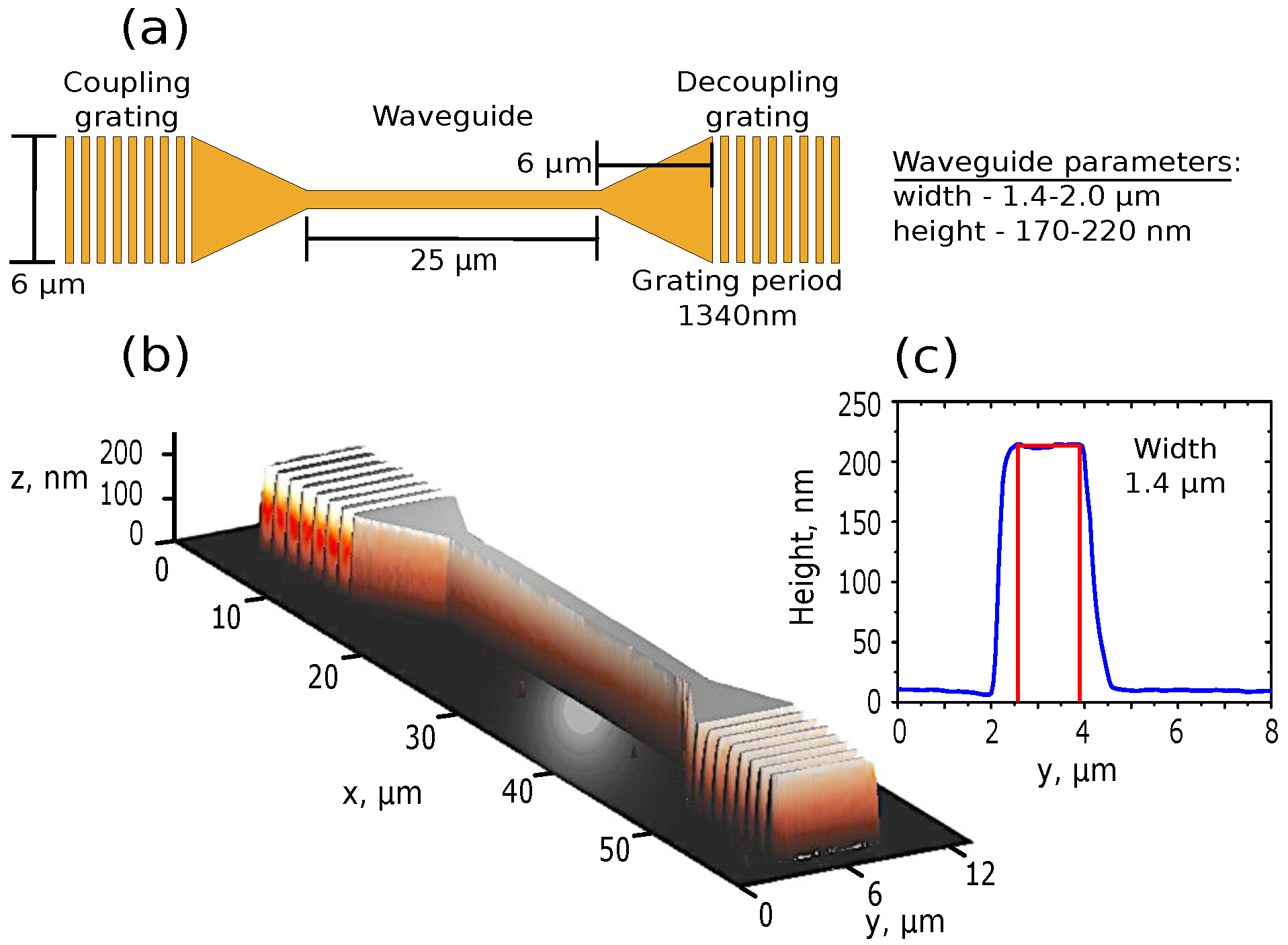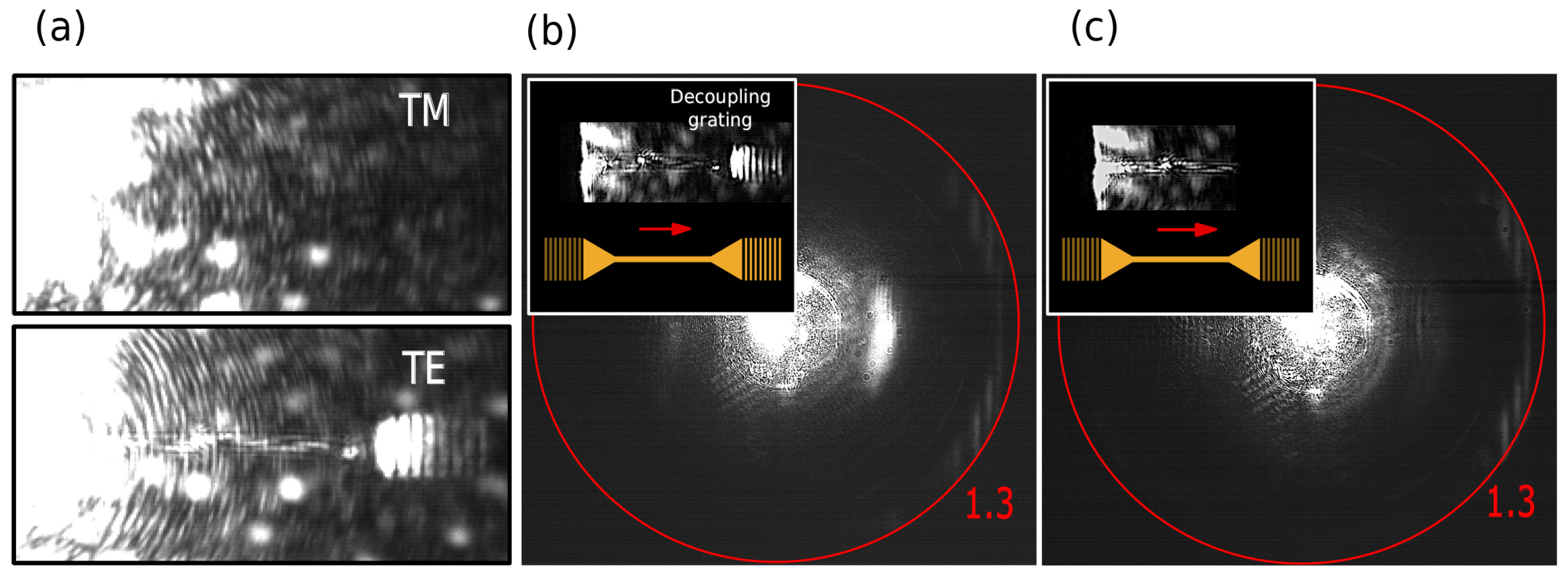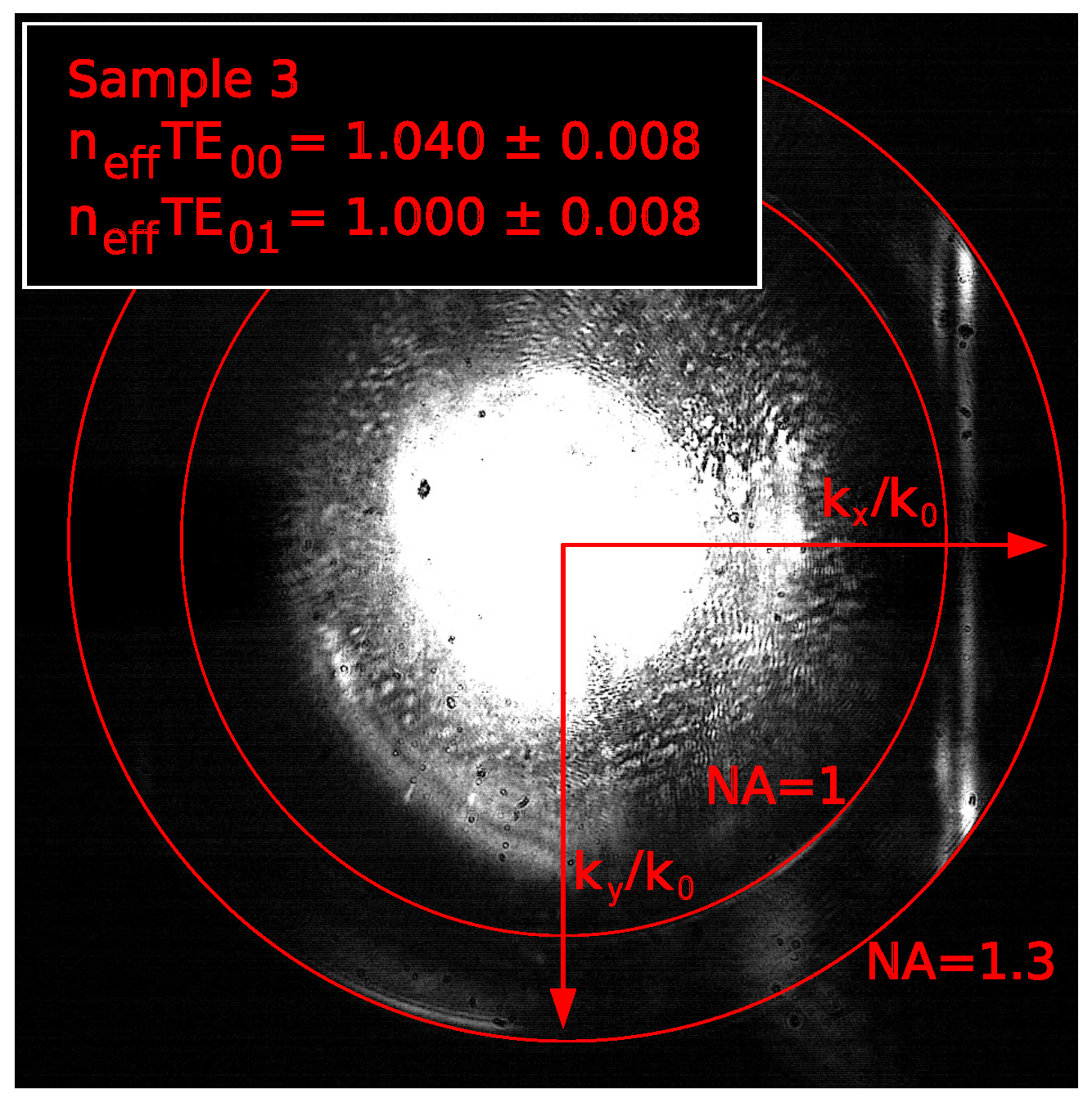Bloch Surface Wave Photonic Device Fabricated by Femtosecond Laser Polymerisation Technique
Abstract
:1. Introduction
2. Materials and Methods
3. Results
4. Discussion
5. Conclusions
Acknowledgments
Author Contributions
Conflicts of Interest
References
- Maradudin, A.A.; Sambles, J.R.; Barnes, W.L. Modern Plasmonics; Elsevier: Amsterdam, The Netherlands, 2014. [Google Scholar]
- Yeh, P.; Yariv, A.; Hong, C.S. Electromagnetic propagation in periodic stratified media. I. General theory. J. Opt. Soc. Am. 1977, 67, 423–438. [Google Scholar] [CrossRef]
- Ramos-Mendieta, F.; Halevi, P. Electromagnetic surface modes of a dielectric superlattice: The supercell method. J. Opt. Soc. Am. B 1997, 14, 370–381. [Google Scholar] [CrossRef]
- Dubey, R.; Barakat, E.; Häyrinen, M.; Roussey, M.; Honkanen, S.K.; Kuittinen, M.; Herzig, H.P. Experimental investigation of the propagation properties of bloch surface waves on dielectric multilayer platform. J. Eur. Opt. Soc. Rapid Publ. 2017, 13, 5. [Google Scholar] [CrossRef]
- Badugu, R.; Mao, J.; Blair, S.; Zhang, D.; Descrovi, E.; Angelini, A.; Huo, Y.; Lakowicz, J.R. Bloch Surface Wave-Coupled Emission at Ultraviolet Wavelengths. J. Phys. Chem. C 2016, 120, 28727–28734. [Google Scholar] [CrossRef] [PubMed]
- Li, Y.; Yang, T.; Song, S.; Pang, Z.; Du, G.; Han, S. Phase properties of Bloch surface waves and their sensing applications. Appl. Phys. Lett. 2013, 103, 041116. [Google Scholar] [CrossRef]
- Paeder, V.; Musi, V.; Hvozdara, L.; Herminjard, S.; Herzig, H. Detection of protein aggregation with a Bloch surface wave based sensor. Sens. Actuators B Chem. 2011, 157, 260–264. [Google Scholar] [CrossRef]
- Qiao, H.; Soeriyadi, A.H.; Guan, B.; Reece, P.J.; Gooding, J.J. The analytical performance of a porous silicon Bloch surface wave biosensors as protease biosensor. Sens. Actuators B Chem. 2015, 211, 469–475. [Google Scholar] [CrossRef]
- Giorgis, F.; Descrovi, E.; Summonte, C.; Dominici, L.; Michelotti, F. Experimental determination of the sensitivity of Bloch surface waves based sensors. Opt. Express 2010, 18, 8087–8093. [Google Scholar] [CrossRef] [PubMed]
- Rivolo, P.; Michelotti, F.; Frascella, F.; Digregorio, G.; Mandracci, P.; Dominici, L.; Giorgis, F.; Descrovi, E. Real time secondary antibody detection by means of silicon-based multilayers sustaining Bloch surface waves. Sens. Actuators B Chem. 2012, 161, 1046–1052. [Google Scholar] [CrossRef]
- Frascella, F.; Ricciardi, S.; Rivolo, P.; Moi, V.; Giorgis, F.; Descrovi, E.; Michelotti, F.; Munzert, P.; Danz, N.; Napione, L.; et al. A fluorescent one-dimensional photonic crystal for label-free biosensing based on Bloch surface waves. Sensors 2013, 13, 2011–2022. [Google Scholar] [CrossRef] [PubMed]
- Sinibaldi, A.; Rizzo, R.; Figliozzi, G.; Descrovi, E.; Danz, N.; Munzert, P.; Anopchenko, A.; Michelotti, F. A full ellipsometric approach to optical sensing with Bloch surface waves on photonic crystals. Opt. Express 2013, 21, 23331–23344. [Google Scholar] [CrossRef] [PubMed]
- Delfan, A.; Liscidini, M.; Sipe, J.E. Surface enhanced Raman scattering in the presence of multilayer dielectric structures. J. Opt. Soc. Am. B 2012, 29, 1863–1874. [Google Scholar] [CrossRef]
- Soboleva, I.; Descrovi, E.; Summonte, C.; Fedyanin, A.; Giorgis, F. Fluorescence emission enhanced by surface electromagnetic waves on one-dimensional photonic crystals. Appl. Phys. Lett. 2009, 94, 231122. [Google Scholar] [CrossRef]
- Romodina, M.; Soboleva, I.; Musorin, A.; Nakamura, Y.; Inoue, M.; Fedyanin, A.A. Bloch-surface-wave- induced Fano resonance in magnetophotonic crystals. Phys. Rev. B 2017, 96, 081401. [Google Scholar] [CrossRef]
- Soboleva, I.; Moskalenko, V.; Fedyanin, A. Giant Goos-Hänchen effect and Fano resonance at photonic crystal surfaces. Phys. Rev. Lett. 2012, 108, 123901. [Google Scholar] [CrossRef] [PubMed]
- Shilkin, D.A.; Lyubin, E.V.; Soboleva, I.V.; Fedyanin, A.A. Near-field probing of Bloch surface waves in a dielectric multilayer using photonic force microscopy. J. Opt. Soc. Am. B 2016, 33, 1120–1127. [Google Scholar] [CrossRef]
- Shilkin, D.A.; Lyubin, E.V.; Soboleva, I.V.; Fedyanin, A.A. Direct measurements of forces induced by Bloch surface waves in a one-dimensional photonic crystal. Opt. Lett. 2015, 40, 4883–4886. [Google Scholar] [CrossRef] [PubMed]
- Descrovi, E.; Sfez, T.; Quaglio, M.; Brunazzo, D.; Dominici, L.; Michelotti, F.; Herzig, H.P.; Martin, O.J.; Giorgis, F. Guided Bloch surface waves on ultrathin polymeric ridges. Nano Lett. 2010, 10, 2087–2091. [Google Scholar] [CrossRef] [PubMed]
- Angelini, A.; Lamberti, A.; Ricciardi, S.; Frascella, F.; Munzert, P.; De Leo, N.; Descrovi, E. In-plane 2D focusing of surface waves by ultrathin refractive structures. Opt. Lett. 2014, 39, 6391–6394. [Google Scholar] [CrossRef] [PubMed]
- Yu, L.; Barakat, E.; Di Francesco, J.; Herzig, H.P. Two-dimensional polymer grating and prism on Bloch surface waves platform. Opt. Express 2015, 23, 31640–31647. [Google Scholar] [CrossRef] [PubMed]
- Descrovi, E.; Barakat, E.; Angelini, A.; Munzert, P.; De Leo, N.; Boarino, L.; Giorgis, F.; Herzig, H.P. Leakage radiation interference microscopy. Opt. Lett. 2013, 38, 3374–3376. [Google Scholar] [CrossRef] [PubMed]
- Angelini, A.; Barakat, E.; Munzert, P.; Boarino, L.; De Leo, N.; Enrico, E.; Giorgis, F.; Herzig, H.P.; Pirri, C.F.; Descrovi, E. Focusing and extraction of light mediated by Bloch surface waves. Sci. Rep. 2014, 4, 5428. [Google Scholar] [CrossRef] [PubMed]
- Kim, M.S.; Vosoughi Lahijani, B.; Descharmes, N.; Straubel, J.; Negredo, F.; Rockstuhl, C.; Hayrinen, M.; Kuittinen, M.; Roussey, M.; et al. Subwavelength focusing of Bloch surface wave. ACS Photonics 2017, 4, 1477–1483. [Google Scholar] [CrossRef]
- Kovalevich, T.; Boyer, P.; Suarez, M.; Salut, R.; Kim, M.S.; Herzig, H.P.; Bernal, M.P.; Grosjean, T. Polarization controlled directional propagation of Bloch surface wave. Opt. Express 2017, 25, 5710–5715. [Google Scholar] [CrossRef] [PubMed]
- Dubey, R.; Lahijani, B.V.; Barakat, E.; Häyrinen, M.; Roussey, M.; Kuittinen, M.; Herzig, H.P. Near-field characterization of a Bloch-surface-wave-based 2D disk resonator. Opt. Lett. 2016, 41, 4867–4870. [Google Scholar] [CrossRef] [PubMed]
- Wang, R.; Xia, H.; Zhang, D.; Chen, J.; Zhu, L.; Wang, Y.; Yang, E.; Zang, T.; Wen, X.; Zou, G.; et al. Bloch surface waves confined in one dimension with a single polymeric nanofibre. Nat. Commun. 2017, 8, 14330. [Google Scholar] [CrossRef] [PubMed]
- Sfez, T.; Descrovi, E.; Yu, L.; Brunazzo, D.; Quaglio, M.; Dominici, L.; Nakagawa, W.; Michelotti, F.; Giorgis, F.; Martin, O.J.; et al. Bloch surface waves in ultrathin waveguides: Near-field investigation of mode polarization and propagation. J. Opt. Soc. Am. B 2010, 27, 1617–1625. [Google Scholar] [CrossRef]
- Wu, X.; Barakat, E.; Yu, L.; Sun, L.; Wang, J.; Tan, Q.; Herzig, H. Phase-sensitive near field Investigation of Bloch surface wave propagation in curved waveguides. J. Eur. Opt. Soc. Rapid Publ. 2014, 9, 14049. [Google Scholar] [CrossRef]
- Yu, L.; Barakat, E.; Nakagawa, W.; Herzig, H.P. Investigation of ultra-thin waveguide arrays on a Bloch surface wave platform. J. Opt. Soc. Am. B 2014, 31, 2996–3000. [Google Scholar] [CrossRef]
- Wollhofen, R.; Katzmann, J.; Hrelescu, C.; Jacak, J.; Klar, T.A. 120 nm resolution and 55 nm structure size in STED-lithography. Opt. Express 2013, 21, 10831–10840. [Google Scholar] [CrossRef] [PubMed]
- Paz, V.F.; Emons, M.; Obata, K.; Ovsianikov, A.; Peterhänsel, S.; Frenner, K.; Reinhardt, C.; Chichkov, B.; Morgner, U.; Osten, W. Development of functional sub-100 nm structures with 3D two-photon polymerization technique and optical methods for characterization. J. Laser Appl. 2012, 24, 042004. [Google Scholar] [CrossRef]
- Petrov, A.K.; Bessonov, V.O.; Abrashitova, K.A.; Kokareva, N.G.; Safronov, K.R.; Barannikov, A.A.; Ershov, P.A.; Klimova, N.B.; Lyatun, I.I.; Yunkin, V.A.; Polikarpov, M.; Snigireva, I.; Fedyanin, A.A.; Snigirev, A. Polymer X-ray refractive nano-lenses fabricated by additive technology. Opt. Express 2017, 25, 14173–14181. [Google Scholar] [CrossRef] [PubMed]
- Stampfl, J.; Liska, R.; Ovsianikov, A. Multiphoton Lithography: Techniques, Materials, and Applications; John Wiley & Sons: Hoboken, NJ, USA, 2016. [Google Scholar]
- Malinauskas, M.; Farsari, M.; Piskarskas, A.; Juodkazis, S. Ultrafast laser nanostructuring of photopolymers: A decade of advances. Phys. Rep. 2013, 533, 1–31. [Google Scholar] [CrossRef]
- Drezet, A.; Hohenau, A.; Stepanov, A.L.; Ditlbacher, H.; Steinberger, B.; Galler, N.; Aussenegg, F.R.; Leitner, A.; Krenn, J.R. How to erase surface plasmon fringes. Appl. Phys. Lett. 2006, 89, 091117. [Google Scholar] [CrossRef]
- Massenot, S.; Grandidier, J.; Bouhelier, A.; Colas des Francs, G.; Markey, L.; Weeber, J.C.; Dereux, A.; Renger, J.; Gonzàlez, M.; Quidant, R. Polymer-metal waveguides characterization by Fourier plane leakage radiation microscopy. Appl. Phys. Lett. 2007, 91, 243102. [Google Scholar] [CrossRef]
- Holmgaard, T.; Bozhevolnyi, S.I.; Markey, L.; Dereux, A. Dielectric-loaded surface plasmon-polariton waveguides at telecommunication wavelengths: Excitation and characterization. Appl. Phys. Lett. 2008, 92, 011124. [Google Scholar] [CrossRef]






| Name | Height, nm | Width, nm | nTE | nTE | nTE |
|---|---|---|---|---|---|
| sample 1 | 200 ± 10 | 1800 ± 100 | 1.106 ± 0.018 | 1.053 ± 0.020 | 1.000 ± 0.015 |
| sample 2 | 200 ± 10 | 1400 ± 100 | 1.098 ± 0.020 | 1.038 ± 0.016 | - |
| sample 3 | 170 ± 10 | 1800 ± 100 | 1.040 ± 0.008 | 1.000 ± 0.008 | - |
| sample 4 | 215 ± 10 | 2000 ± 100 | 1.161 ± 0.010 | 1.116 ± 0.010 | 1.037 ± 0.012 |
© 2018 by the authors. Licensee MDPI, Basel, Switzerland. This article is an open access article distributed under the terms and conditions of the Creative Commons Attribution (CC BY) license (http://creativecommons.org/licenses/by/4.0/).
Share and Cite
Abrashitova, K.A.; Gulkin, D.N.; Safronov, K.R.; Kokareva, N.G.; Antropov, I.M.; Bessonov, V.O.; Fedyanin, A.A. Bloch Surface Wave Photonic Device Fabricated by Femtosecond Laser Polymerisation Technique. Appl. Sci. 2018, 8, 63. https://doi.org/10.3390/app8010063
Abrashitova KA, Gulkin DN, Safronov KR, Kokareva NG, Antropov IM, Bessonov VO, Fedyanin AA. Bloch Surface Wave Photonic Device Fabricated by Femtosecond Laser Polymerisation Technique. Applied Sciences. 2018; 8(1):63. https://doi.org/10.3390/app8010063
Chicago/Turabian StyleAbrashitova, Ksenia A., Dmitry N. Gulkin, Kirill R. Safronov, Natalia G. Kokareva, Ilya M. Antropov, Vladimir O. Bessonov, and Andrey A. Fedyanin. 2018. "Bloch Surface Wave Photonic Device Fabricated by Femtosecond Laser Polymerisation Technique" Applied Sciences 8, no. 1: 63. https://doi.org/10.3390/app8010063





